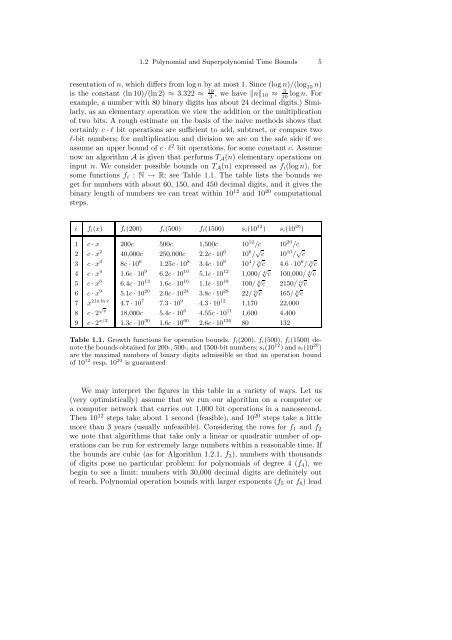Dietzfelbinger M. Primality testing in polynomial time ... - tiera.ru
Dietzfelbinger M. Primality testing in polynomial time ... - tiera.ru
Dietzfelbinger M. Primality testing in polynomial time ... - tiera.ru
You also want an ePaper? Increase the reach of your titles
YUMPU automatically turns print PDFs into web optimized ePapers that Google loves.
1.2 Polynomial and Super<strong>polynomial</strong> Time Bounds 5<br />
resentation of n, which differs from log n by at most 1. S<strong>in</strong>ce (log n)/(log10 n)<br />
is the constant (ln 10)/(ln 2) ≈ 3.322 ≈ 10<br />
3 ,wehave�n�10 ≈ 3<br />
10 log n. For<br />
example, a number with 80 b<strong>in</strong>ary digits has about 24 decimal digits.) Similarly,<br />
as an elementary operation we view the addition or the multiplication<br />
of two bits. A rough estimate on the basis of the naive methods shows that<br />
certa<strong>in</strong>ly c · ℓ bit operations are sufficient to add, subtract, or compare two<br />
ℓ-bit numbers; for multiplication and division we are on the safe side if we<br />
assume an upper bound of c · ℓ2 bit operations, for some constant c. Assume<br />
now an algorithm A is given that performs TA(n) elementary operations on<br />
<strong>in</strong>put n. We consider possible bounds on TA(n) expressed as fi(log n), for<br />
some functions fi : N → R; see Table 1.1. The table lists the bounds we<br />
get for numbers with about 60, 150, and 450 decimal digits, and it gives the<br />
b<strong>in</strong>ary length of numbers we can treat with<strong>in</strong> 1012 and 1020 computational<br />
steps.<br />
i fi(x) fi(200) fi(500) fi(1500) si(10 12 ) si(10 20 )<br />
1 c · x 200c 500c 1,500c 10 12 /c 10 20 2 c · x<br />
/c<br />
2<br />
40,000c 250,000c 2.2c · 10 6<br />
10 6 / √ c 10 10 / √ 3 c · x<br />
c<br />
3<br />
8c · 10 6<br />
1.25c · 10 8<br />
3.4c · 10 9<br />
10 4 / 3√ c 4.6 · 10 6 / 3√ 4 c · x<br />
c<br />
4<br />
1.6c · 10 9<br />
6.2c · 10 10<br />
5.1c · 10 12<br />
1,000/ 4√ c 100,000/ 4√ 5 c · x<br />
c<br />
6<br />
6.4c · 10 13<br />
1.6c · 10 16<br />
1.1c · 10 19<br />
100/ 6√ c 2150/ 6√ 6 c · x<br />
c<br />
9<br />
5.1c · 10 20<br />
2.0c · 10 24<br />
3.8c · 10 28<br />
22/ 9√ c 165/ 9√ c<br />
7 x 2lnlnx<br />
4.7 · 10 7<br />
7.3 · 10 9<br />
4.3 · 10 12<br />
8 c · 2<br />
1,170 22,000<br />
√ x<br />
18,000c 5.4c · 10 6<br />
4.55c · 10 11<br />
1,600 4,400<br />
9 c · 2 x/2<br />
1.3c · 10 30<br />
1.6c · 10 60<br />
2.6c · 10 120<br />
80 132<br />
Table 1.1. Growth functions for operation bounds. fi(200), fi(500), fi(1500) denote<br />
the bounds obta<strong>in</strong>ed for 200-, 500-, and 1500-bit numbers; si(10 12 )andsi(10 20 )<br />
are the maximal numbers of b<strong>in</strong>ary digits admissible so that an operation bound<br />
of 10 12 resp. 10 20 is guaranteed<br />
We may <strong>in</strong>terpret the figures <strong>in</strong> this table <strong>in</strong> a variety of ways. Let us<br />
(very optimistically) assume that we <strong>ru</strong>n our algorithm on a computer or<br />
a computer network that carries out 1,000 bit operations <strong>in</strong> a nanosecond.<br />
Then 10 12 steps take about 1 second (feasible), and 10 20 steps take a little<br />
more than 3 years (usually unfeasible). Consider<strong>in</strong>g the rows for f1 and f2<br />
we note that algorithms that take only a l<strong>in</strong>ear or quadratic number of operations<br />
can be <strong>ru</strong>n for extremely large numbers with<strong>in</strong> a reasonable <strong>time</strong>. If<br />
the bounds are cubic (as for Algorithm 1.2.1, f3), numbers with thousands<br />
of digits pose no particular problem; for <strong>polynomial</strong>s of degree 4 (f4), we<br />
beg<strong>in</strong> to see a limit: numbers with 30,000 decimal digits are def<strong>in</strong>itely out<br />
of reach. Polynomial operation bounds with larger exponents (f5 or f6) lead












